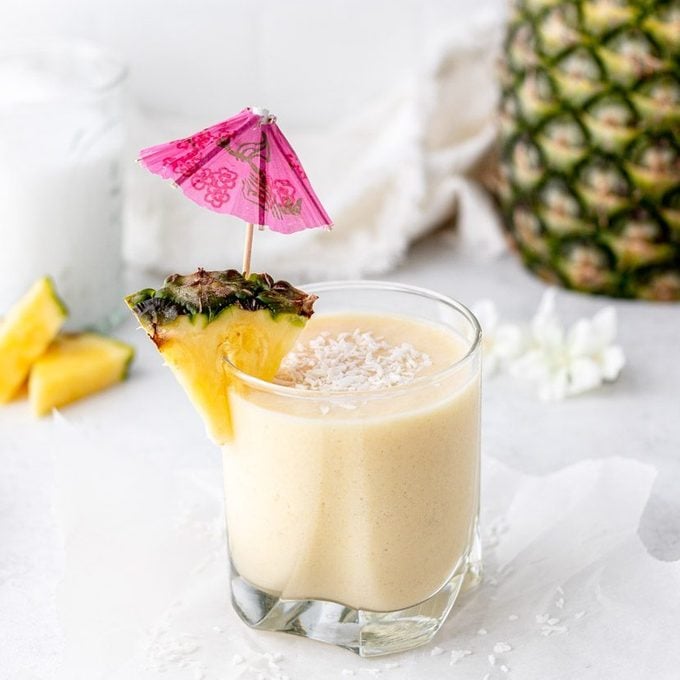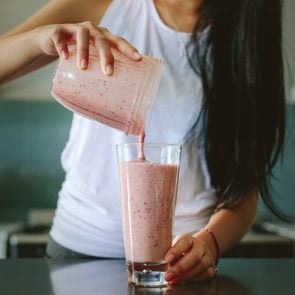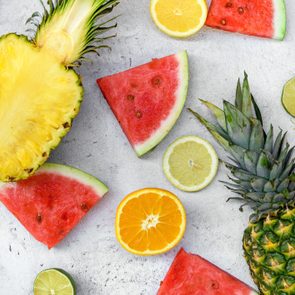A Pineapple Smoothie Recipe That’s Healthy and Delicious
Updated: Jul. 21, 2021
Here's a registered dietitian's recipe for making a delicious pineapple smoothie that's gluten free, dairy free, and vegan.
Why pineapple is an underrated smoothie ingredient
Love eating a bowl of pineapple chunks? I know I do, and I wanted to share one of the best pineapple recipes with you. (Read on for more details.)
Nothing screams delicious treat quite like this tropical fruit—which also happens to taste amazing when blended into a pineapple smoothie.
Where do pineapples come from? Originally from South America, Christopher Columbus and Sir Walter Raleigh wrote about pineapples, and in the 1500s, the Portuguese introduced the pineapple to Africa, India, and other parts of the world.
Today, the pineapple is grown in India, China, Brazil, Costa Rica, and Thailand, as well as other countries.
Benefits of pineapple
No doubt you’re familiar with the tangy sweetness of pineapple. But do you also know about the health benefits of the fruit?
“A one-cup serving of pineapple offers a healthy dose of vitamin C,” says Elysia Cartlidge, a registered dietitian in Ontario, Canada.
“This not only helps improve your immune function but can also assist the body in the formation of collagen, a key contributor to wound healing.”
One cup of pineapple provides 79 milligrams of vitamin C, which is 88 percent of the daily value (DV).
You get beneficial minerals, too.
“One cup of this fruit provides an excellent source of manganese, a mineral that plays a key role in the health of bones and tissue,” says Cartlidge. You’ll also find bromelain in pineapple.
“This group of enzymes can aid with digestion and has anti-inflammatory and cancer-fighting properties,” adds Cartlidge.

Why this pineapple smoothie is so awesome
If you love pineapple recipes, you’ll truly enjoy sipping this pineapple smoothie. And now that you know of the many reasons to love pineapple, let’s talk about why you should whip up this delicious pineapple smoothie from Cartlidge.
“The combination of the coconut milk, banana, and frozen pineapple results in a rich and creamy taste and texture that’s ultra-cool and refreshing,” she says.
“The fruit provides just the right amount of sweetness so that no additional form of sweetener is required.”
Add an umbrella straw to a smoothie, and pretend you’re sipping a piña colada.
“If you’re looking to escape to an island in your backyard, this smoothie will help you do it as it has tropical vibes in every sip,” says Cartlidge.
“The flavor resembles that of your classic piña colada but without the added sugar.”
(Here’s what to know about pineapple calories.)
Nutrition of this pineapple smoothie recipe
Per each serving of this pineapple smoothie, you’ll get the following. Note that the nutrition info does not reflect optional ingredients.
- Calories: 160
- Fat: 1 gram (1 percent DV)
- Saturated fat: 1 gram (1percent DV)
- Sodium: 86 milligrams (4 percent DV)
- Carbohydrates: 40 grams (15 percent DV)
- Fiber: 4 grams (14 percent DV)
- Sugar: 34 grams
- Protein: 2 grams
- Calcium: 109 milligrams (8 percent DV)
- Iron: 1 milligram (6 percent DV)
- Potassium: 369 milligrams (8 percent DV)
Why this pineapple smoothie recipe is healthy
You already know why eating pineapple is good for you. Now, let’s talk about the other ingredients in the pineapple smoothie.
The smoothie recipe also contains bananas.
“Bananas are a source of potassium and magnesium,” notes Cartlidge.
“The combination of potassium and magnesium, along with the carbohydrates, makes bananas an optimal pre- or post-workout option for athletes—as they provide energy while also helping to reduce risk of muscle cramps.”
And bananas, like pineapple, boast fiber. “The fiber found in bananas can help keep you regular and prevent constipation,” says Cartlidge.
You’ll also find coconut milk in this smoothie recipe.
“Coconut milk contains vitamin C and vitamin E, which can help to boost the immune system,” says Cartlidge. And coconut milk contains lauric acid.
“This component helps protect against many viruses and infections, as it has anti-viral and anti-fungal properties,” she adds.
Benefits of nutrients in this recipe
In just one serving of this pineapple smoothie, you’ll get four grams of fiber.
“This can leave you feeling fuller for longer, so you’re less likely to overeat at meal times and give in to cravings,” says Cartlidge.
“Dietary fiber can also promote regularity and lower cholesterol levels—and can aid in achieving a healthy weight.”
The smoothie provides benefits for your exercise routine, too.
“If consumed post-workout, the quick-absorbing natural sugars from the fruit can help replenish glycogen stores,” adds Cartlidge.
“If you choose to add in protein powder, this can help rebuild and repair the muscle that has been broken down during your workout.”
Other substitutions to make
This recipe already fits various needs—it’s vegan, dairy-free, and gluten-free. But that doesn’t mean you can’t play around with the ingredients.
“If desired, you can substitute the coconut milk with another milk alternative such as soy or almond milk,” says Cartlidge. “However, this may alter the taste and texture of the smoothie.”
How to blend this pineapple smoothie
Ingredients
- 2 cups frozen pineapple chunks
- 1 medium overly ripe banana, sliced
- 1 ¼ cups canned coconut milk
- 1 scoop protein powder (optional)
- Dried and shredded unsweetened coconut flakes (optional)
Directions
Add all ingredients to a high-power blender. Gradually turn the blender up to high speed, and blend until smooth and creamy.
You may wish to add the frozen fruit in small batches and/or add additional liquid if the blender is having trouble breaking down the fruit.
For best results, serve immediately, topped with a sprinkle of coconut if desired. It makes four servings.
Ready to cook more with pineapple? Try these recipes:





















